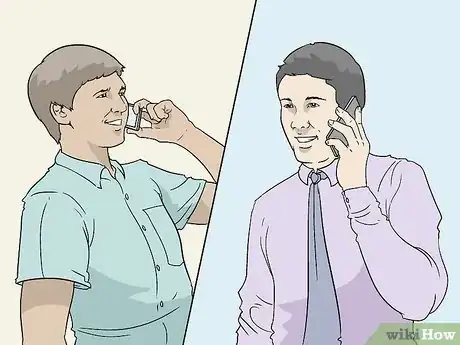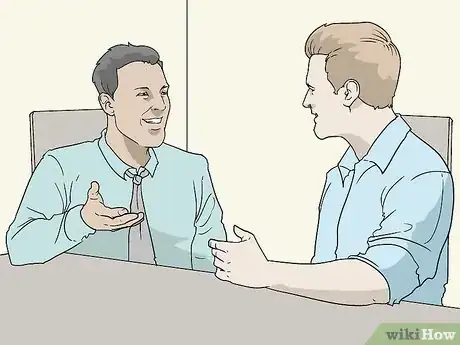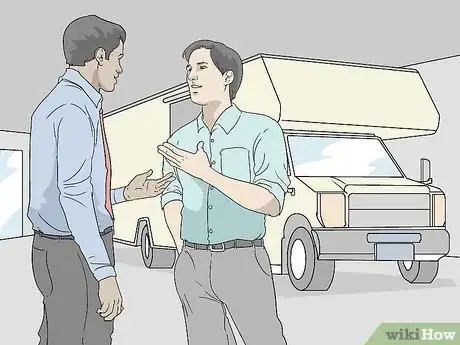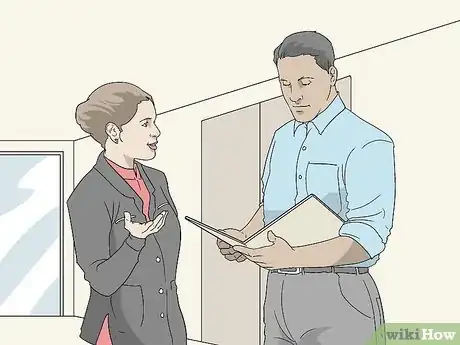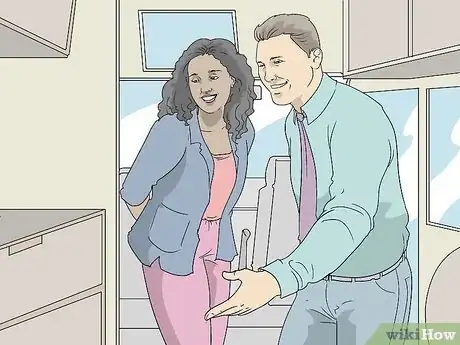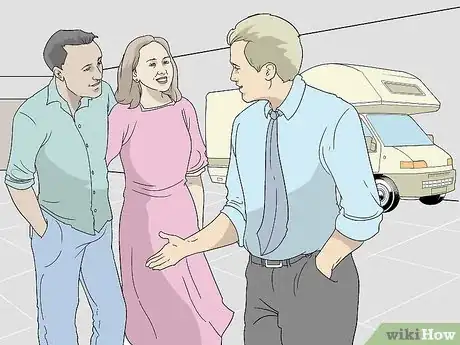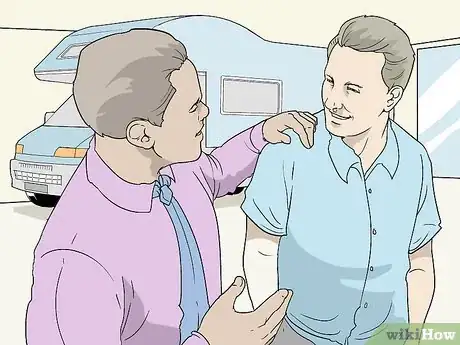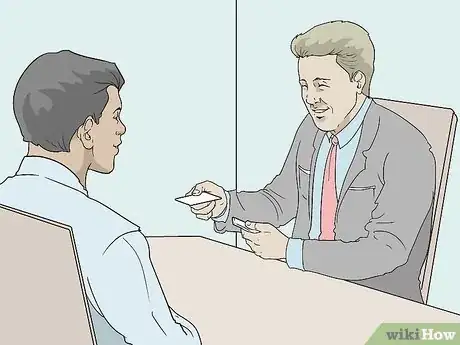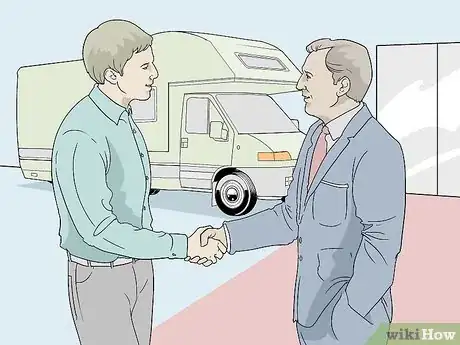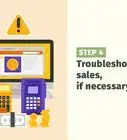This article was co-authored by wikiHow Staff. Our trained team of editors and researchers validate articles for accuracy and comprehensiveness. wikiHow's Content Management Team carefully monitors the work from our editorial staff to ensure that each article is backed by trusted research and meets our high quality standards.
There are 12 references cited in this article, which can be found at the bottom of the page.
This article has been viewed 7,993 times.
Learn more...
Becoming a successful RV salesperson is all about establishing trust. That’s why it’s so important to dispense with the usual dealership run-around and get right down to doing business in an honest, straightforward manner. As a sales rep, your main goal should be to put your buyer at ease and give them all the information they need to find a vehicle that suits their individual needs and preferences. Once you’ve made it past the all-important interview stage, locking down a sale is often as simple as asking the right questions and letting your inventory speak for itself.
Steps
Earning Your Buyer's Trust
-
1Greet prospective buyers with enthusiasm. As soon as you answer the phone or approach an interested party on your lot, give them your name and ask them what you can help them with. Getting them talking is the first step towards developing a rapport, which in turn will earn their trust and make them more likely to want to do business with you.[1]
- Remember to smile. The atmosphere at a dealership can be intimidating to some people, and a warm smile can be a good way to break that initial tension.
- Don’t waste valuable time making small talk about things like the weather or what’s on TV. Get right to what they’re there for, which is to shop for an RV.[2]
-
2Explain the buying process in clear, simple terms. After greeting your buyer, let them know what they can expect during their visit. Try not to overcomplicate things or bombard them with unnecessary industry jargon. Instead, walk them through what comes next in a way they can easily understand. Doing so will make them feel better prepared so they can shop with confidence.[3]
- Depending on how you like to conduct face-to-face meetings, you might say something like, “The first thing I’m going to have you do is flip through the literature for a few models that sound like what you’re after. Then, we’ll head down to the lot to take a closer look. Does that sound good?”
Advertisement -
3Ask questions that will help you find them a vehicle that suits their needs. Take a few minutes to find out why the person is interested in buying an RV in the first place. Getting a more specific idea of what your buyer has in mind will allow you to narrow down many possible options to a small handful that they’ll find most enticing.[4]
- Questions like, “How do you plan on using your RV?”, “How many people will you be bringing along with you?”, and “Do you plan on towing any other vehicles?” will give both of you a clearer vision of the role their RV will play in their lives.
Tip: Many top sales reps recommend conducting this initial interview in your office or desk space. That way, your buyer will be more comfortable with the official surroundings once it’s time to discuss financing.[5]
-
4Be honest when sharing your own opinions about your inventory. Nobody likes dealing with someone who tells them everything they want to hear in order to get something. Don’t hesitate to tell your buyer what you truly think when going over the particulars of various vehicles. Chances are, they’ll appreciate your sincerity and feel even better about buying from you.[6]
- Find tactful ways to phrase your personal takes to avoid devaluing the product you’re selling, like, “To be honest, I’m not the biggest fan of this design, but most of our customers love it” or, “Even though I prefer a slightly larger dining area, this one sounds like it will work perfectly for your needs.”
- You want your dialogue with your buyer to be relaxed and sincere, as if the two of you were old friends chatting over dinner.[7]
Demoing Vehicles Effectively
-
1Show 2-3 RVs that most closely match what your buyer is looking for. Once you have an idea of the kind of vehicle they have their eye on, use your expertise to pick out a few models that fit the bill. Be sure to explain the subtle differences between each vehicle and point out any unique features or advantages that you think might influence their final decision.[8]
- Most RVs will look pretty similar to first-time buyers, so don’t assume that they’ll notice features that could prove to be major selling points: “This model has doors for the bathroom and sleeping areas, where as the first couple we looked at only had curtains, if you remember.”[9]
- If you show your buyer too many different vehicles, they may feel confused or overwhelmed by the sheer number of options, which will ultimately just frustrate them and make it harder for them to make up their minds.
Warning: Resist the temptation to guide them towards featured models that don’t line up with their budget or personal preferences for the sake of padding your own sales record. Remember, your job is to help them end up with a vehicle that they actually want.[10]
-
2Make your demo an interactive experience as opposed to a passive one. Talking up a vehicle from a distance isn’t going to knock anyone’s socks off. Treat your prospective buyer to a full tour—open doors and cabinets, pull out drawers, and demonstrate firsthand how different appliances and fixtures work. Encourage the buyer to take some time to poke around for themselves, as well.[11]
- Don’t be in too big of a rush to move onto the next model if your buyer doesn’t seem impressed right off the bat. It could be that they just haven’t yet seen the thing that’s ultimately going to win them over.
- Comprehensive, hands-on demos give buyers an opportunity to visualize themselves owning and using various models.
-
3Appeal to your buyer’s sentimental reasons for wanting an RV. Instead of simply rattling off a list of features and amenities like a walking brochure, tailor your spiel to remind them of some of the ways that owning an RV might improve their lives. Getting them to focus on what they stand to gain from a personal standpoint can make a high sticker price seem more reasonable, and may even be enough to convince them to buy right then and there.[12]
- Describing a dining area as “spacious” won’t have nearly the same emotional impact as “big enough to make breakfast with the family.”
- If a prospect says something like, “I’m just not sure it’s in my budget right now. Maybe in a year or two,” point out how much they’re missing out on with a response like, “Why wait years when you can start making memories today?”
-
4Put off discussing prices until you’re ready to close. As much as possible, try to avoid talking turkey while you’re still on the lot. Not only will it kill the momentum of a solid demo, it may also cause your buyer to bail if they don’t like what they hear. Your goal is to get them back to your office, where it won’t be as easy for them to walk away if they start getting cold feet.[13]
- If your customer leads with, “What’s the cheapest model you’ve got?” try coming back with, “That depends on a few different factors. I’d be more than happy to go over some basic options with you.”
Closing the Sale
-
1Prompt your buyer for feedback to gauge their level of interest. Every time you demo one of the vehicles on your list, throw out a trial close like, “Is the RV for you?” or, “Do you think you’re ready to talk about financing?” If your buyer responds positively, you can lead them straight back to your office to get started on the necessary paperwork instead of burning daylight pushing products that they have no intention of buying.[14]
- Do your best to get a “yay” or “nay” without coming across as pushy or overly eager to make a sale. You just want to get a better sense of where they stand on a particular model, not make them feel pressured.
- This is also an ideal time to share your professional opinion, answer questions, and put to rest any nagging worries that your buyer may have.
-
2Invite the buyer back to your office to crunch the numbers. Writing up your buyer—giving them a targeted quote based on their finances and other considerations—is arguably the most crucial part of the sales process. If you sense that they like what they see, gently nudge them towards the dotted line by saying, “Should we go get the paperwork in order?” or something similar. This will prompt them to seal the deal before any last-minute doubts have a chance to arise.[15]
- Getting 100% of your clients to the write-up stage is the key to maximizing your sales.
- In most cases, your buyer will be much more likely to pull the trigger on their purchase if you can get them to look over the numbers and agree to putting the terms of the deal down on paper.
Tip: If possible, wait until you have the buyer in your office to talk about knocking down the asking price. Strategic price-drops tend to be more effective the closer the buyer is to signing.
-
3Avoid putting off your buyer with negative language during negotiations. Rather than saying, “I’m sorry, we can’t do that,” for instance, try, “Let me see what I can do.” Similarly, if a buyer comes to you with an unusual request, a good go-to reply is, “Let me speak with my manager. We may be able to work something out.” This preserves good will and keeps the door open for further haggling.[16]
- This doesn’t necessarily mean that you should be equally flexible about every aspect of a sale. If a certain offer or condition is a no-go, it’s best to be up front about it, but in a friendly, agreeable way.
- The last thing you want is to seem uncooperative, especially when you’re poised to seal the deal.
-
4Follow up with your prospect regularly until they’re ready to make a decision. Every salesman worth their salt knows that the job doesn’t end when the buyer leaves the lot. The same day that you meet with an interested party, call, text, or email them to thank them for coming buy and address any questions or concerns they might have brought up during their visit. Get in the habit of touching base about once a week until they make their ultimate decision.[17]
- Ask your client what their preferred method of communication is and make it your main avenue of correspondence to ensure that your messages are well-received.[18]
- Likewise, make sure the buyer leaves with your personal phone number as well as your number and email address at the dealership so that you’ll be available to field their inquiries at all times.
-
5Keep in touch with satisfied customers to score new leads. Make it a point to reach out to past clients periodically to see if they’re still happy with their vehicle. When you do, make sure you include a call-to-action asking them to keep you in mind if they know anyone else who’s in the market for an RV. This keeps the door open for future transactions.[19]
- Sending the occasional email or text message can be a nice gesture, but try to limit post-purchase phone calls (or avoid them altogether). Most people don’t like to be bothered with annoying sales calls while they’re still shopping around, let alone after they’ve already bought something.
- Following up with a buyer shows them that you’re genuinely concerned about their satisfaction and aren’t just out to make a quick buck. This kind of show of faith is a recipe for repeat business or referrals.[20]
References
- ↑ https://www.youtube.com/watch?v=miqXubPV5Tg&feature=youtu.be&t=20
- ↑ https://blog.markgrowth.com/my-rv-sales-process-that-helped-me-sell-rv-after-rv-5cd6a09bbeb
- ↑ https://blog.markgrowth.com/my-rv-sales-process-that-helped-me-sell-rv-after-rv-5cd6a09bbeb
- ↑ https://www.rvt.com/blog/buying-and-selling/tips-for-the-rv-sales-lot/
- ↑ https://blog.markgrowth.com/my-rv-sales-process-that-helped-me-sell-rv-after-rv-5cd6a09bbeb
- ↑ https://www.thefitrv.com/blog/my-days-as-an-rv-salesman/
- ↑ https://www.rvingplanet.com/blog/the-salesperson-and-listening-to-your-gut/
- ↑ https://blog.markgrowth.com/my-rv-sales-process-that-helped-me-sell-rv-after-rv-5cd6a09bbeb
- ↑ https://thervatlas.com/podcast/rv-shopping-the-rv-features-that-really-matter/
- ↑ https://www.rvingplanet.com/blog/the-salesperson-and-listening-to-your-gut/
- ↑ https://thervatlas.com/podcast/rv-shopping-the-rv-features-that-really-matter/
- ↑ https://www.youtube.com/watch?v=bWVXc4xZpSs&feature=youtu.be&t=113
- ↑ https://blog.markgrowth.com/my-rv-sales-process-that-helped-me-sell-rv-after-rv-5cd6a09bbeb
- ↑ https://blog.markgrowth.com/my-rv-sales-process-that-helped-me-sell-rv-after-rv-5cd6a09bbeb
- ↑ https://www.cbtnews.com/totd-grant-cardone-write-up/
- ↑ https://www.rvda.org/App_Themes/RVDAMercury/docs/Convention%20Documents/Speaker%20Handouts%202015/NancyFriedmanRVDA2015.pdf
- ↑ https://blog.markgrowth.com/my-rv-sales-process-that-helped-me-sell-rv-after-rv-5cd6a09bbeb
- ↑ https://www.saleshacker.com/the-5-keys-to-an-effective-follow-up/
- ↑ https://www.bdc.ca/en/articles-tools/marketing-sales-export/sales/pages/effective-sales-follow-up-5-simple-steps.aspx
- ↑ https://www.entrepreneur.com/article/240439
